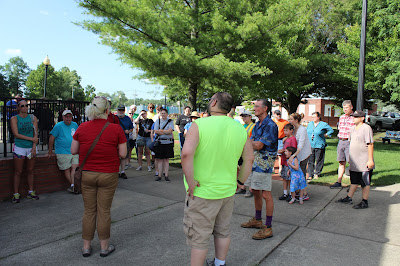My name is
Alexander Nikolai Bacik, and I am a current student and intern here at the Fort
St. Joseph Archaeological dig in Niles, Michigan. I am 25 years old, and am
finishing my senior year as a Public History major at Western Michigan
University in nearby Kalamazoo. Two days ago, we got to experience the Niles Historic
Walking Tour, which hasn’t been done since the 1990’s! As a tour guide myself,
as well as a reenactor (I am a Union Civil War Drummer with a Fife and Drum
Corp.), I really could appreciate if not learn from what I thought was truly a
fun and unique learning experience, as it was not a typical historic tour, in
that it was conducted outside and was truly done for the public (it will surely
inspire me for future ideas of my own, as I hope to lead tours one day). This
is very important, as academic history is needed and has its place; it is
public history and its historians that go out and truly bring the history of
the people to the common man in an understandable and interesting way, as that
is the goal of public history.
The tour started
out at the Niles Amphitheater near the North Bridge, and continued its way by
the river front, with our tour guide, Mollie Watson, explaining the various
histories and fun facts along the way. This included such topics as river
traffic and industry, the Michigan Central Railroad and its impact on the river
trade and the State, as well as the various businesses that used to line the
river front, with the French Paper Mill being the only survivor left standing.
It is the only company in the United States to survive in the same family for
over 150 years. The next part of the tour, which was led by our own miss Erika
Hartley, started out at the Dam and continued down the dirt road to the Cross
of Father Alloway, and finally to the commemorative rock, which was
appropriately decorated with the “four” flags (being that of France, England,
Spain, and of course, America). As a religious and spiritual individual, I
could really appreciate him, as his memorial attested not only to his
missionary zeal, but also to his kindness to God’s Children. During the tour, Erika
talked about of course the Native Americans (the Potawatomi tribe was one of
them), the French and their missionaries, the Fur Trade and its impact, the
Fort and its role in the New World, and so on. Finally, the guests were led
through the nature trail that us students cut out early in our program, and
finally made it to the dig site. Some of the students explained to eager ears about
the excavation, particularly their findings, as well as the terminology that is
used and what they mean. All of this put together means so much in the long
scope of things, in that everyday people can feel that they too are part of
this story, as well as see their home in a new appreciation and light with the
use of history. The provided illustrations, as well as being outdoors, also
helped put what once was into an understandable reality. That is why public
history is so great. Tours like this can bring people together and give them a
healthy sense of pride about their history and where they come from as a
community.
This is why the
Fort St. Joseph Archaeological Project has lasted so long, in that it has, and
continues to foster support from the community in showing them the beneficial
outcomes of archaeology. Showing the public the actual dig site is very
important to the interest of the project, as people get to see where our
efforts as students go, as well as where one’s donations are applied. For many
people outside of the history world, it can be hard to comprehend what goes on
and why one should care, especially if one grew up with history being present
in a very dry and boring way. History, like archaeology, is meant to be alive,
with museums, tour guides, and reenactors helping in bringing that history
alive, so that people may hopefully walk away with a better understanding of
the past and theirs, as well as learning from the good and the bad. As the
saying goes, you “cannot move forward unless you learn from the past…”






No comments:
Post a Comment